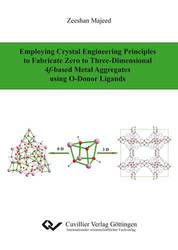| Departments | |
|---|---|
| Book Series (96) |
1378
|
| Nachhaltigkeit |
3
|
| Gesundheitswesen |
1
|
| Humanities |
2364
|
| Natural Sciences |
5406
|
| Mathematics | 229 |
| Informatics | 319 |
| Physics | 980 |
| Chemistry | 1363 |
| Geosciences | 131 |
| Human medicine | 243 |
| Stomatology | 10 |
| Veterinary medicine | 108 |
| Pharmacy | 147 |
| Biology | 835 |
| Biochemistry, molecular biology, gene technology | 121 |
| Biophysics | 25 |
| Domestic and nutritional science | 45 |
| Agricultural science | 1004 |
| Forest science | 201 |
| Horticultural science | 20 |
| Environmental research, ecology and landscape conservation | 148 |
| Engineering |
1793
|
| Common |
98
|
|
Leitlinien Unfallchirurgie
5. Auflage bestellen |
|
Advanced Search
Employing Crystal Engineering Principles to Fabricate Zero to Three-Dimensional 4f-based Metal Aggregates using O-Donor Ligands (English shop)
Zeeshan Majeed (Author)Preview
Extract, PDF (960 KB)
Table of Contents, PDF (130 KB)
Interest in lanthanide (Ln) coordination chemistry has increased significantly over the past few years, in particular as a result of their intriguing spectral and magnetic properties. LnIII ions are “hard acids” and generally prefer to coordinate with “hard bases” such as O- and F-donor ligands. Their coordination geometries are usually determined by ligand steric factors rather than crystal field effects. The research described in this dissertation mainly focuses on the interaction of LnIII ions with O-donor ligands such as carboxylates and polyols, while aiming to synthesize Ln-based polynuclear coordination compounds having interesting magnetic properties. Moreover, investigation of the influence of ligand back-bone on the magneto-structural properties of the resulting compounds was explored. Consequently some novel and efficient one-pot synthetic methodologies have been successfully developed to prepare Ln-based polynuclear clusters as well as networks of various dimensionalities, displaying exciting magnetic properties. Also correlations between structural parameters and magnetic properties have been established. The resulting compounds were characterized in detail using analytical methods like FT-IR, elemental analysis, single crystal XRD, powder XRD, and magnetic SQUID measurements.
The first approach, based upon a systematic study of Ln-carboxylate chemistry, has led to the isolation of two 1D chains possessing single chain magnet (SCM) properties, a 2D honeycomb network, two chiral metal-organic frameworks (MOFs) and one porous MOF showing slow relaxation of the magnetisation. This study has increased the understanding of the self-assembly processes of LnIII ions under the influence of various aliphatic as well as aromatic carboxylate ligands. The second approach relies upon introducing an additional polyol ligand into the Lncarboxylate system, in order to investigate further the magneto-structural variations of the binary ligand system. This led to a variety of discrete molecular clusters ranging in nuclearity from 3 to 26, exhibiting SMM behavior. In addition to this, two 1D polymers with the highest energy barriers to reversal of the magnetization found for 4f-based single chain magnets reported so far and a 2D honeycomb network showing slow relaxation of its magnetization have been characterized. The third approach aimed to incorporate an additional metal ion, such as MnII, into the Ln-polyol-carboxylate system, thereby synthesizing heterometallic complexes with interesting magnetic properties. This resulted in a series of mixed-valent heterometallic decanuclear clusters exhibiting SMM behavior. Finally, the organic polyol ligand was replaced with a purely inorganic polyoxometalate anion, in order to synthesize some organic/inorganic hybrid materials with novel magnetic properties. This resulted in a series of polynuclear aggregates some of which show SMM behavior.
| ISBN-13 (Hard Copy) | 9783954043521 |
| ISBN-13 (eBook) | 9783736943520 |
| Final Book Format | A5 |
| Language | English |
| Page Number | 226 |
| Lamination of Cover | matt |
| Edition | 1. Aufl. |
| Publication Place | Göttingen |
| Place of Dissertation | Karlsruhe |
| Publication Date | 2013-02-08 |
| General Categorization | Dissertation |
| Departments |
Chemistry
|
| Keywords | Anorganische Chemie |








